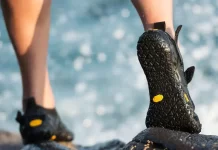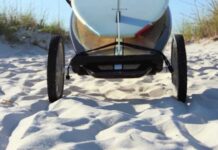When it comes to engaging in stand-up paddleboarding (SUP), prioritizing safety is of utmost importance. And a key component of staying safe on the water is wearing a personal flotation device (PFD). But with so many different types and brands of PFDs available, how do we know which ones meet the necessary safety standards? In this article, we will explore the essential safety standards that your SUP PFD should meet, ensuring that you are well-equipped and protected while enjoying your paddleboarding adventures.
Types of SUP PFDs
Types of inflatable PFDs
Inflatable PFDs are a popular choice among Stand-Up Paddleboard (SUP) enthusiasts due to their lightweight and comfortable design. These PFDs are typically made with a durable nylon fabric and contain an inflatable chamber that can be manually or automatically activated to provide buoyancy when needed. The inflatable design allows for easy movement while paddling, making them ideal for active water sports like SUP.
Types of foam PFDs
Foam PFDs, also known as buoyancy aids, are another common type of PFD used for SUP activities. These PFDs are made with foam inserts that provide buoyancy and floatation. Foam PFDs are typically designed to be more secure and offer a higher level of buoyancy than inflatable PFDs. They are a popular choice for beginners or individuals who may be less comfortable with relying solely on inflation mechanisms.
Hybrid PFDs
Hybrid PFDs combine the features of both inflatable and foam PFDs. These PFDs usually have a foam core for buoyancy, supplemented by an inflatable chamber. Hybrid PFDs offer the best of both worlds, providing the comfort and flexibility of an inflatable PFD with the added security and buoyancy of foam. They are a great option for individuals seeking a balance between comfort, freedom of movement, and safety.
Approval categories for SUP PFDs
SUP PFDs are classified into different approval categories based on their design and intended use. The three main categories recognized by the U.S. Coast Guard (USCG) are Type I, Type II, and Type III. Type I PFDs are designed for rough waters and offer the highest level of buoyancy, while Type II and Type III PFDs are suitable for calmer waters and less extreme conditions. It is important to select a SUP PFD that is appropriate for the specific water conditions you will be paddling in.
US Coast Guard (USCG) Regulations
USCG-approved SUP PFDs
When selecting a SUP PFD, it is crucial to choose one that is USCG-approved. USCG-approved PFDs are manufactured to meet strict safety standards and are tested for buoyancy, durability, and performance. Look for the USCG approval label on the PFD, which ensures that it has undergone rigorous testing and is suitable for use in SUP activities.
Minimum buoyancy requirements
The USCG sets minimum buoyancy requirements for PFDs, including those used for SUP. For adults, the minimum buoyancy requirement is typically 15.5 pounds, while for children, it is lower at 11 pounds. It is important to ensure that the SUP PFD you choose meets or exceeds these minimum requirements to ensure proper floatation and safety in the water.
Labeling requirements for SUP PFDs
USCG regulations also specify labeling requirements for SUP PFDs. All PFDs must have labels that provide information on size, intended use, and limitations. Additionally, the label must include instructions for proper fitment and maintenance. It is essential to carefully read and follow these instructions to ensure the effective and safe use of your SUP PFD.
ISO Certification
ISO 12402-5 for inflatable PFDs
In addition to USCG approval, inflatable PFDs may also be certified to meet ISO standards. ISO 12402-5 is the specific standard for inflatable PFDs. This certification ensures that the PFD meets the necessary performance, design, and construction requirements. When considering an inflatable SUP PFD, look for those that are ISO 12402-5 certified to have an additional layer of assurance regarding their safety and quality.
ISO 12402-6 for foam PFDs
Foam PFDs can also be certified to meet ISO standards, specifically ISO 12402-6. This certification ensures that foam PFDs meet the necessary buoyancy and safety requirements. When choosing a foam SUP PFD, consider those that have been ISO 12402-6 certified to ensure that they have undergone proper testing and meet the necessary standards.
ISO 12402-9 for hybrid PFDs
Hybrid PFDs can also be certified to meet ISO standards, namely ISO 12402-9. This standard ensures that the buoyancy aids meet the necessary requirements for performance, buoyancy, and safety features. When considering a hybrid SUP PFD, look for those that are ISO 12402-9 certified to ensure that they meet the necessary safety standards.
Buoyancy and Flotation
Minimum buoyancy for SUP PFDs
The minimum buoyancy requirements set by the USCG ensure that a SUP PFD provides adequate floatation in case of an emergency. It is essential to select a PFD with sufficient buoyancy to keep you afloat and provide support while paddling. The recommended minimum for adults is around 15.5 pounds, but it is always better to opt for a SUP PFD with higher buoyancy levels for added safety.
Additional flotation features for enhanced safety
Some SUP PFDs come with additional flotation features to enhance safety. These may include extra foam inserts, built-in neck support, or back panels designed to keep your head above water. These features can provide added peace of mind and ensure that you remain safe and buoyant in the water.
Considerations for different body weights
When choosing a SUP PFD, consider your body weight and ensure that the PFD’s buoyancy rating is suitable for your weight. Each SUP PFD will have a specified weight range that it is designed to accommodate. It is important to select a size that matches your weight to ensure optimal buoyancy and a secure fit.
Fit and Comfort
Proper size and fit for SUP PFDs
The proper fit is crucial when it comes to SUP PFDs. A PFD that is too loose or too tight can limit your mobility or compromise its effectiveness in the water. Size charts are typically provided by manufacturers to help determine the appropriate size based on your measurements. Take accurate measurements of your chest and waist and refer to these size charts to find the best fit for your SUP PFD.
Adjustability for different body types
Many SUP PFDs offer adjustability features such as straps or buckles to accommodate different body types. These adjustable features allow you to customize the fit and ensure a secure and comfortable PFD. Look for SUP PFDs that provide ample adjustability options to cater to different body shapes and sizes.
Ergonomic designs for comfort during SUP activities
SUP PFDs are designed with ergonomics in mind to provide comfort during paddling. Look for PFDs with contoured foam or inflatable chambers that allow for freedom of movement and do not restrict your range of motion. Additionally, SUP PFDs with mesh panels or ventilation systems can help keep you cool and comfortable during your paddling adventures.
Visibility and Reflective Materials
Bright colors and high-visibility designs
Visibility is of utmost importance when participating in water sports, including SUP. SUP PFDs are available in a variety of bright colors to enhance visibility and make it easier for others to spot you in the water. Colors such as orange, yellow, and neon green are popular choices for SUP PFDs as they stand out against the water and provide greater visibility.
Reflective strips and patches for low-light conditions
For SUP paddlers who enjoy early morning or late evening sessions, it is important to have a PFD with reflective strips or patches. These reflective elements help improve visibility in low-light conditions and can assist in locating you in case of an emergency. Look for SUP PFDs that have strategically placed reflective materials for enhanced safety during twilight or nighttime paddling.
Whistle and Personal Locator Devices (PLDs)
Built-in whistle on SUP PFDs
Many SUP PFDs come equipped with a built-in whistle as an additional safety feature. A whistle can be a valuable tool for attracting attention and signaling for help in emergency situations. Having a whistle readily available on your PFD ensures that you have a means of alerting others of your presence or distress while out on the water.
Optional PLD attachments for emergency situations
Some SUP PFDs offer the option to attach personal locator devices (PLDs) such as GPS or tracking devices. These PLDs can be incredibly useful in emergency situations, allowing rescuers to quickly locate you and provide assistance. While not essential for all SUP activities, having the option to attach a PLD can provide added peace of mind, especially if you paddle in remote or less frequented areas.
Durability and Construction
Quality materials for long-lasting SUP PFDs
Durability is an important factor to consider when choosing a SUP PFD. Look for PFDs made with high-quality materials such as durable nylon, reinforced stitching, and corrosion-resistant hardware. These materials contribute to the overall longevity and performance of the PFD, ensuring that it can withstand the rigors of SUP activities and provide reliable safety and buoyancy.
Reinforced stitching and reinforced parts
Reinforced stitching is a crucial aspect of SUP PFD construction. PFDs that undergo extensive stress and movement require reinforced stitching to withstand the forces exerted on them. Additionally, reinforced parts, such as shoulder straps, buckles, and closures, contribute to the overall durability and longevity of the PFD. When selecting a SUP PFD, examine the construction, paying attention to reinforced areas and sturdy stitching.
Resistance to wear, tear, and UV exposure
SUP PFDs are exposed to various environmental elements, including water, sun, and repeated use. It is important to choose a PFD that is resistant to wear, tear, and UV exposure. Look for PFDs that are UV-resistant and have protective coatings to prevent fading, deterioration, or damage caused by sun exposure. Additionally, opt for PFDs made with durable materials that can withstand the wear and tear associated with regular SUP activities.
User Reviews and Recommendations
Researching SUP PFD brands and models
Before making a purchase, it is helpful to research different SUP PFD brands and models to gain insights into their performance, durability, and customer satisfaction. Read product descriptions, explore manufacturer websites, and compare reviews to gather information that can guide your decision-making process.
Reading customer reviews and feedback
Customer reviews and feedback offer valuable real-world experiences and opinions on SUP PFDs. Pay attention to reviews from individuals who have used the PFDs in SUP activities, as their insights can provide detailed information on comfort, fit, buoyancy, and durability. Look for common themes or issues mentioned in reviews to identify potential pros and cons of different SUP PFDs.
Considering personal preferences and needs
Ultimately, the best SUP PFD is one that meets your personal preferences and needs. Consider factors such as design, color, adjustability, and additional features to find a PFD that aligns with your specific requirements. Whether you prioritize comfort, visibility, or specific safety features, choosing a SUP PFD that suits your preferences will enhance your overall experience on the water.
Conclusion
Prioritizing safety when selecting a SUP PFD
When engaging in SUP activities, safety should always be a top priority. Selecting a suitable SUP PFD that meets relevant safety standards is essential to ensure optimal buoyancy and protection in the water. Consider factors such as PFD type, USCG approval, ISO certification, buoyancy, fit, comfort, visibility, whistle, and PLD options, durability, and user reviews when choosing a SUP PFD.
Choosing a SUP PFD that meets relevant safety standards
By choosing a SUP PFD that meets the necessary safety standards, you can enjoy your SUP adventures with peace of mind, knowing that you are equipped with a reliable and effective flotation device. Take the time to research different SUP PFD options, consider your personal preferences and needs, and consult user reviews to find the perfect PFD that aligns with your requirements for safety, performance, and comfort. Paddle safely and enjoy the exhilarating experience of Stand-Up Paddleboarding!





































